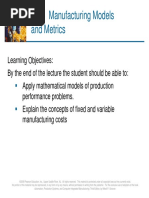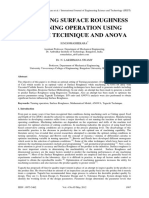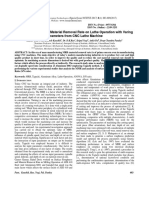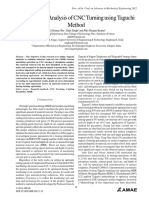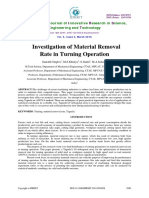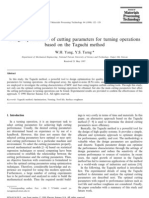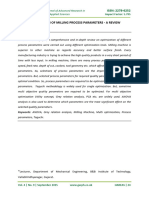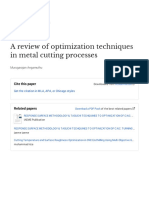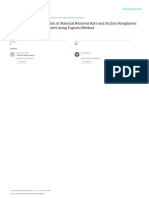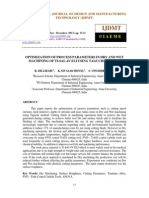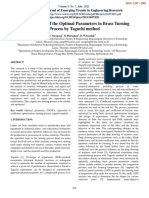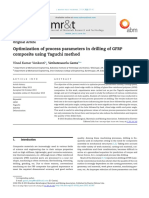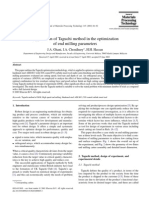IJMSE
IJMSE
Uploaded by
Shafayat HossainCopyright:
Available Formats
IJMSE
IJMSE
Uploaded by
Shafayat HossainCopyright
Available Formats
Share this document
Did you find this document useful?
Is this content inappropriate?
Copyright:
Available Formats
IJMSE
IJMSE
Uploaded by
Shafayat HossainCopyright:
Available Formats
International Journal of Materials Science and Engineering
Optimization of Metal Removal Rate for ASTM A48 Grey
Cast Iron in Turning Operation Using Taguchi Method
Md. Maksudul Islam1*, Sayed Shafayat Hossain2, Md. Sajibul Alam Bhuyan2
1 Department of Industrial Engineering & Management, Khulna University of Engineering & Technology,
Khulna, Bangladesh.
2 Department of Mechanical Engineering, Khulna University of Engineering & Technology, Khulna,
Bangladesh.
* Corresponding author. Tel.: +8801626408123; email: maksudkhandakar@gmail.com
Manuscript submitted December 16, 2014; accepted May 8, 2015.
doi: 10.17706/ijmse.2015.3.2.134-146
Abstract: Optimization is a technique through which better results are obtained under certain
circumstances. The main objective of today’s modern manufacturing industries is to produce low cost and
high quality products in short time. The selection of optimal cutting parameters is a very important issue
for every machining process in order to enhance the quality of machining products and reduce the
machining costs. This research work represents on an optimization of metal removal rate in turning
operation by the effects of machining parameters applying Taguchi & ANOVA (Analysis of Variance) method
to improve the quality of manufactured goods & engineering development of designs for studying variations.
For investigation ASTM A48 grey cast iron is considered as workpiece and spindle sped, feed rate & depth of
cut have been considered as cutting parameters, while a HSS (High Speed Steel) has been used as cutting
tool. This research work reveals that spindle speed has the most significant contribution on the metal
removal rate among all the three parameters.
Key words: ANOVA, design of experiments, orthogonal array, Taguchi method.
1. Introduction
Turning is one of the most commonly used metal removal operations in industry because of its ability to
remove material faster giving reasonably good surface quality. It is used in a variety of manufacturing
industries including aerospace and automatic sectors. During turning process we expect highest metal
removal rate in order to achieve highest production at reduced time and cost. Metals from the outer
periphery of a cylindrical work piece are removed and the volume of metal removed per unit time is known
as metal removal rate or MRR. A turning machine or lathe, work piece, fixture, and cutting tool are required
during the turning operation. The workpiece is a piece of re-shaped metal that is secured to the fixture,
which itself is attached to the turning machine, and allowed to rotate at high speeds. The cutter is typically a
single-point cutting tool that is also secured in the machine. The cutting tool feeds into the rotating work
piece and cuts away material in the form of small chips to create the desire shape.
In the turning operation, vibration is a frequent problem, which affects the result of the machining and in
particular the surface finish. Tool life is also influenced by vibrations. Severe acoustic noise in the working
environment frequently results as a dynamic motion between the cutting tool and the work piece. In all
cutting operations like turning, boring and milling vibrations are induced due to deformation of the work
134 Volume 3, Number 2, June 2015
International Journal of Materials Science and Engineering
piece. In the turning process, the importance of machining parameter choice is increased, as it controls the
surface quality required. [1]
Dr Genichi Taguchi is a Japanese quality management consultant who has developed and promoted a
philosophy and methodology for continuous quality improvement in products and processes. Within this
philosophy, Taguchi shows how the statistical design of experiments (SDOE or DOE) can help industrial
engineers design and manufacture products that are both of high quality and low cost. His approach is
primarily focused on eliminating the causes of poor quality and on making product performance insensitive
to variation. DOE (Design of Experiment) is a powerful statistical technique for determining the optimal
factor settings of a process and thereby achieving improved process performance, reduced process
variability and improved manufacturability of products and processes. Taguchi (1986) advocates the use of
orthogonal array designs to assign the factors chosen for the experiment. The most commonly used
orthogonal array designs are L8 (i.e. eight experimental trials), L16 and L18. The power of the Taguchi
method is that it integrates statistical methods into the engineering process. Bendell et al. (1989) and
Rowlands et al. (2000) report success of the Taguchi method in the automotive, plastics, semiconductors,
and metal fabrication and foundry industries. [2]
The Taguchi method has been widely used in engineering analysis and is a powerful tool to design a high
quality system. Moreover, the Taguchi method employs a special design of orthogonal array to investigate
the effects of the entire machining parameters through the small number of experiments. By applying the
Taguchi technique, the time required for experimental investigations can be significantly reduced, as it is
effective in the investigation of the effects of multiple factors on performance as well as to study the
influence of individual factors to determine which factor has more influence. [3]
The aim of this experimental investigation is to estimate the effects of cutting speed, feed rate, and depth
of cut on Material Removal Rate in Turning of mild steel. Design of experiment techniques, i.e. Taguchi’s
technique have been used to accomplish the objective and to generate optimized value. Here L27
orthogonal array used for conducting the experiments and ANOVA technique was employed to analyze the
percentage contribution and influence of Process Parameters.
Fig. 1. Rendered picture of turning operation (Drawn in Solid Works 2013)
2. Literature Review
Traditionally, the selection of cutting conditions for metal cutting is left to the machine operator. In such
cases, the experience of the operator plays a major role, but even for a skilled operator it is very difficult to
attain the optimum values each time. The main machining parameters in metal turning operations are
135 Volume 3, Number 2, June 2015
International Journal of Materials Science and Engineering
cutting speed, feed rate and depth of cut etc. The setting of these parameters determines the quality
characteristics of turned parts. K. Palanikumar, et al. [4] discussed the application of the Taguchi method
with fuzzy logic to optimize the machining parameters for machining of GFRP (Glass Fiber Reinforced
Plastic) composites with multiple characteristics. A multi response performance index (MRPI) was used for
optimization. The machining parameters like work piece (fiber orientation), cutting speed, feed rate, depth
of cut, and machining time were optimized with consideration of multiple performance characteristics like
metal removal rate, tool wear, and surface roughness. T. Srikanth and V. kamala [5] developed a real coded
Genetic Algorithm (RCGA) approach for optimization of cutting parameters in turning. This RCGA approach
is quite advantageous in order to have the minimum surface roughness values, and their corresponding
optimum cutting parameters, for certain constraints [5]. S. S. Mahapatra et al. [6] an attempt has been made
to generate a surface roughness prediction model and optimize the process parameters using Genetic
algorithms. Adeel H. Suhail et al [7] conducted experimental study to optimize the cutting parameters using
two performance measures, work piece surface temperature and surface roughness. Optimal cutting
parameters for each performance measure were obtained employing Taguchi techniques. The orthogonal
array, signal to noise ratio and analysis of variance were employed to study the performance characteristics
in turning operation.
The experimental results showed that the work piece surface temperature can be sensed and used
effectively as an indicator to control the cutting performance and improves the optimization process. T.G
Ansalam Raj and V. N Narayanan Namboothiri [8] formed an improved genetic algorithm for the prediction
of surface finish in dry turning of SS 420 materials.
Taguchi offers a simple and systematic approach to optimize a performance, quality and cost. The quality
of design can be improved by improving the quality and productivity in various company-wide activities.
Those activities concerned with quality include in quality of product planning, product design and process
design (Park 1996, Ranjit 2001) [9] [10].
Taguchi’s parameter design offers a simple and systematic approach which can reduce number of
experiments to optimize design for performance, quality and cost. Signal to Noise(S/N) ratio and
orthogonal array (OA) are two major tools used in robust design. S/N ratio measures quality with emphasis
on variation, and OA accommodates many design factors simultaneously (Park 1996, Phadke 1998) [9] [11].
Tong L. et al. (1997), proposed a procedure in this study to achieve the optimization of multi-response
problems in the Taguchi method which includes four phases, i.e. computation of quality loss, determination
of the multi-response S/N ratio, determination of optimal factor/level condition and performing the
confirmation experiment [12].
Ficici F. et al. (2011) have used the Taguchi method to study the wear behavior of bronzed AISI 1040 steel.
They have used orthogonal array, S/N ratio and ANOVA to investigate the optimum setting parameters [13].
3. Methodology
3.1. Specification of Work Material
For performing turning operations ASTM A48 grey cast iron materials have been used. They were in the
form of cylindrical bar of diameter 30mm and cutting length 67mm. The material composition of ASTM A48
grey cast iron has given below.
Table 1. Chemical Composition of ASTM A48 Grey Cast Iron
C Si Mn Fe
3.40 1.80 0.50 Balanced
136 Volume 3, Number 2, June 2015
International Journal of Materials Science and Engineering
3.2. Process Parameters
Table 2. Process Parameter for Investigation
Spindle
Feed rate(f) Depth of
Speed (s)
Level (mm/rev) cut(d) (mm)
(rpm)
1 112 0.125 0.25
2 175 0.138 0.30
3 280 0.153 0.35
3.3. Taguchi Method
The Taguchi experimental design method is a well-known, unique and powerful technique for product or
process quality improvement. It is widely used for analysis of experiment and product or process
optimization. Taguchi has developed a methodology for the application of factorial design experiments that
has taken the design of experiments from the exclusive world of the statistician and brought it more fully
into the world of manufacturing [14]. Traditional experimental design methods are very complicated and
difficult to use. Additionally, these methods require a large number of experiments when the number of
process parameters increases. In order to minimize the number of experiments required, Taguchi
experimental design method, a powerful tool for designing high-quality system. This method uses a special
design of orthogonal arrays to study the entire parameter space with minimum number of experiments [15].
Taguchi strategy is the conceptual framework or structure for planning a product or process design
experiment
3.4. Analysis of Variance (ANOVA)
Analysis of variance (ANOVA) is a statistical method for determining the existence of differences among
several population means. While the aim of ANOVA is the detect differences among several populations
means, the technique requires the analysis of different forms of variance associated with the random
samples under study- hence the name analysis of variance. The original ideas analysis of variance was
developed by the English Statistician Sir Ronald A. Fisher during the first part of this century. Much of the
early work in this area dealt with agricultural experiments where crops were given different treatments,
such as being grown using different kinds of fertilizers. The researchers wanted to determine whether all
treatments under study were equally effective or whether some treatments were better than others [16].
ANOVA is used to determine the influence of any given process parameters from a series of experimental
results by design of experiments and it can be used to interpret experimental data. Since there will be large
number of process variables which control the process, some mathematical model are require to represent
the process. However these models are to be developing using only the significant parameters which
influences the process, rather than including all the parameters.
4. Experimentation and Mathematical Modeling
4.1. Choice of Orthogonal Array Design
The choice of a suitable orthogonal array (OA) design is critical for the success of an experiment and
depends on the total degrees of freedom required to study the main and interaction effects, the goal of the
experiment, resources and budget available and time constraints. Orthogonal arrays allow one to compute
the main and interaction effects via a minimum number of experimental trials (Ross, 1988). ‘‘Degrees of
freedom’’ refers to the number of fair and independent comparisons that can be made from a set of
137 Volume 3, Number 2, June 2015
International Journal of Materials Science and Engineering
observations. In the context of SDOE, the number of degrees of freedom is one less than the number of
levels associated with the factor. In other words, the number of degrees of freedom associated with a factor
at p-levels is (p-1). As the number of degrees of freedom associated with a factor at two levels is unity. The
number of degrees of freedom associated with an interaction is the product of the number of degrees of
freedom associated with each main effect involved in the interaction (Antony, 1998) [2].
4.2. Mathematical Formulation and Experimental Data
The experiment is conducted for Dry turning operation (without cutting fluid) of using cast iron as work
material and high speed steel as tool material on a conventional lathe machine. The tests are carried for a
67 mm length work material. The process parameters used as spindle speed (rpm), feed (mm/rev), depth of
cut (mm). The response variable is material removal rate and the experimental results are recorded in Table
3. Material removal rate is calculated by following formula.
Let,
D i = Initial diameter of the metal bar,
D f = Final diameter of the metal bar,
L =Cutting length of workpiece,
t =time
π =3.1416(Constant value)
Now,
Volume = π/4L D2 i - π/4L D2 f
= π/4L (D2 i -D2 f)
= π/4L (D i + D f) (D i - D f)
= π L {(D i + D f)/2} {(D i - D f)/2}
= π L (Average diameter) (Depth of cut)
Fig. 2. Schematic view of cutting section.
From Fig. 1,
D i - D f = 2d [Where, d = Depth of cut]
d = (D i - D f)/2
And,
(D i + D f)/2 = Average diameter of the cutting section = D avg
So, Experimental formula for M.R.R
𝜋×𝐿×𝑑×𝐷𝑎𝑣𝑔
= 𝑡
mm3/sec (1)
138 Volume 3, Number 2, June 2015
International Journal of Materials Science and Engineering
Creating orthogonal arrays for the parameter design indicates the number of condition for each
experiment. The selection of orthogonal arrays is based on the number of parameters and the level of
variation for each parameter.
For the maximum material removal rate, the solution is “Larger is better” and S/N ratio is determined
according to the following equation:
S/N = -10 log10 {n-1∑y-2} (2)
where,
S/N = Signal to Noise Ratio,
n = No. of Measurements,
y = Measured Value
(a)
(b)
Fig. 3. (a) Cast iron after turning operation (b) High speed steel (HSS) cutting tool
From the Table 3 it is seen that at the same spindle speed and feed rate, the time should be longer with
depth of cut deeper but it is opposite in this table because it is actual experimental value & cutting fluid is
not used. In this experiment, at first the tip of the cutting tool was sharp, but after continuous turning
operation it was gradually blunted. So the blunted tip is the reason for the fluctuation of time during metal
removal operation.
139 Volume 3, Number 2, June 2015
International Journal of Materials Science and Engineering
Table 3. Experimental Data and Results for L27 Orthogonal Array
Final Average Metal removal
Spindle Depth of
Exp Feed rate Time Initial dia, Di dia, dia, rate,
speed cut
no. (mm/rev) t(sec) (mm) Df Davg MRR
(rpm) (mm)
(mm) (mm) (mm3/s)
1. 112 0.125 0.25 458 29.70 29.20 29.45 3.38
2. 112 0.125 0.30 455 29.20 28.60 28.90 4.01
3. 112 0.125 0.35 457 28.60 27.90 28.25 4.55
4. 112 0.138 0.25 439 27.90 27.40 27.65 3.31
5. 112 0.138 0.30 435 27.40 26.80 27.10 3.93
6. 112 0.138 0.35 438 26.80 26.10 26.45 4.45
7. 112 0.153 0.25 421 26.10 25.60 25.85 3.23
8. 112 0.153 0.30 418 25.60 25.00 25.30 3.82
9. 112 0.153 0.35 420 25.00 24.30 24.65 4.32
10. 175 0.125 0.25 276 24.30 23.80 24.05 4.59
11. 175 0.125 0.30 271 23.80 23.20 23.50 5.48
12. 175 0.125 0.35 274 23.20 22.50 22.85 6.14
13. 175 0.138 0.25 248 22.50 22.00 22.25 4.72
14. 175 0.138 0.30 245 22.00 21.40 21.70 5.59
15. 175 0.138 0.35 247 21.40 20.70 21.05 6.28
16. 175 0.153 0.25 225 20.70 20.20 20.45 4.78
17. 175 0.153 0.30 221 20.20 19.60 19.90 5.69
18. 175 0.153 0.35 223 19.60 18.90 19.25 6.36
19. 280 0.125 0.25 185 18.90 18.40 18.65 5.30
20. 280 0.125 0.30 181 18.40 17.80 18.10 6.31
21. 280 0.125 0.35 183 17.80 17.10 17.45 7.02
22. 280 0.138 0.25 166 17.10 16.60 16.85 5.32
23. 280 0.138 0.30 163 16.60 16.00 16.30 6.31
24. 280 0.138 0.35 164 16.00 15.30 15.65 7.03
25. 280 0.153 0.25 145 15.30 14.80 15.05 5.46
26. 280 0.153 0.30 142 14.80 14.20 14.50 6.45
27 280 0.153 0.35 144 14.20 13.50 13.85 7.09
Table 4. Response Table of Means for MRR of Cast Iron
Level Spindle speed Feed rate Depth of cut
1. 3.89 5.20 4.46
2. 5.51 5.22 5.29
3. 6.26 5.24 5.92
The mean value of the cutting parameters are shown in the Table 4, and this is used to calculate the
analysis of variance (ANOVA) which is shown in the Table 5.
Table 5. ANOVA for the Response Metal Removal Rate
Source Degree of freedom Sum of square Mean of square F ratio % of contribution
Spindle speed 2 26.37 13.19 62.81 72.35
Feed rate 2 0.0072 0.0036 0.017 0.02
Depth of cut 2 9.65 4.83 23.00 26.48
Error 2 0.42 0.21 1.15
Total 8 36.45 100
140 Volume 3, Number 2, June 2015
International Journal of Materials Science and Engineering
From the above Table 5, it is observed that the spindle speed (72.35%), depth of cut (26.48%) have great
influence on metal removal rate. The parameter feed rate (0.02%) has small influence. Since this is a
parameter based optimization design, from the above values it is clear that spindle speed (72.35%) is the
prime factor to be effectively selected to get the effective material removal rate.
Design of experiment for material removal rate L9 orthogonal array is prepared by carrying out a total
number of 9 experiments along with 2 verification (X and Y data) experiments. For Y data, 9 set of new
experiments is conducted in terms of data representation of Table 6. In L9 array 9 rows represent the 9
experiment to be conducted with 3 columns at 3 levels of the corresponding factor. The matrix form of this
array is shown in Table 6.
Classical experimental design methods are too complex and are not easy to use a large number of
experiments have to be carried out when the number of process parameters increases. To solve this
problem, the Taguchi method uses a special design of orthogonal arrays to study the entire parameter space
with only a small number of experiments [8].
Table 6. Calculation of Signal to Noise Ratio for MRR
Parameters level MRR (mm3/s) Signal to noise
Exp. No
ratio
Spindle speed Feed rate Depth of cut X Y (S/N ratio)
1. 112 0.125 0.25 3.38 3.43 39.67
2. 112 0.138 0.30 3.93 3.96 45.39
3. 112 0.153 0.35 4.32 4.36 43.72
4. 175 0.125 0.30 5.48 5.51 48.27
5. 175 0.138 0.35 6.28 6.30 52.96
6. 175 0.153 0.25 4.78 4.82 44.59
7. 280 0.125 0.35 7.02 7.04 53.93
8. 280 0.138 0.25 5.34 5.37 48.04
9. 280 0.153 0.30 6.45 6.46 53.19
The experimental data for the metal removal rate values and the calculated signal-to-noise ratio are
shown in Table 6. The S/N ratio values of the material removal rate are calculated, using higher the better
characteristics. Conceptual S/N ratio approach of Taguchi method provides a simple, systematic and
efficient methodology for optimizing of process parameters and this approach can be adopted rather than
using engineering judgment. This implies that engineering systems behave in such a way that the
manipulated production factors that can be divided into three categories:
1) Control factors, which affect process variability as measured by the S/N ratio.
2) Signal factors, which do not influence the S/N ratio or process mean.
3) Factors, which do not affect the S/N ratio or process mean.
In practice, the target mean value may change during the process development applications in which the
concept of S/N ratio is useful are the improvement of quality through variability reduction and the
improvement of measurement. The S/N ratio characteristics can be divided into three categories when the
characteristic is continuous: nominal is the best, smaller the better and larger is better characteristics.
Based on Taguchi prediction that the bigger different in value of S/N ratio shows a more effect on material
removal rate or more significant. Therefore, it can be concluded that, augmentation of the spindle speed
increases the metal removal rate significantly and it is shown in Table 7. Here delta is the difference
between the maximum and minimum value of signal to noise ratio for each parameter. The highest delta
141 Volume 3, Number 2, June 2015
International Journal of Materials Science and Engineering
value is ranked as first parameter which possesses the maximum influence in metal removal rate of ASTM
A48 grey cast iron.
Table 7. Response Table for Signal to Noise Ratio for MRR
level Spindle speed Feed rate Depth of cut
1. 42.93 47.29 44.22
2. 48.61 48.80 48.95
3. 51.72 47.17 50.20
Delta(max-min) 8.79 1.63 5.98
Rank 1 3 2
From Table 7 it is clear that the spindle speed is the most significant parameter for maximizing metal
removal rate as its rank is first.
5. Results and Discussions
5.1. Equation for Optimization of Metal Removal Rate
From the linear regression analysis (running a program in Minitab 17) the following equation has
derived:
MRR= -1.92+0.0134*(Spindle speed) +1.67*(Feed rate) + 14.60*(Depth of cut)
5.2. Graphical Representation
In the above experimental results, two techniques of data analysis have been used. Both techniques draw
similar conclusions. The spindle speed has found to be the most significant effect to produce high value of
average metal removal rate (MRR). The explanation for the influence of cutting speed on metal removal rate
is still not available. This could be explained in terms of the velocity of chips that is faster at high cutting
speed than at low cutting speed. This leads to a shorter time for the chips to be in contact with the newly
formed surface of workpiece and the tendency for the chips to wrap back to the new face form is little as
compared to low speed. The condition of seizure and sub layer plastic flow occurred at high speed and the
term flow-zone is used to describe secondary deformation in this range [17]. The time taken for the chips at
this flow-zone for high speed cutting is short as compared to lower speed, as the velocity of chip is faster
[18]. The use of S/N ratio for selecting the best levels of combination for metal removal rate (MRR) value
suggests the use of high value of spindle speed in order to obtain good removal rate. Therefore, it is
preferable to set the depth of cut to a high value. From the Table 3 it is clear that the optimal cutting
parameters are level 3 of spindle speed, feed rate, and depth of cut in Table 2 to obtain good quantity of
metal removal rate (MRR) and which is also indicated in Table 8. From the result, the interaction of spindle
speed and depth of cut is more important than the effect of the individual factors. In other words, in order
to get the best result it requires experience to combine these two factors to achieve a suitable combination
of spindle speed and depth of cut. Form the graph of the Minitab it is clear that spindle speed have the
maximum influence for high metal removal rate.
Table 8. Optimal Sequence for Maximum MRR
Spindle speed Feed rate Depth of cut Metal removal rate (MRR)
280 0.153 0.35 7.09
142 Volume 3, Number 2, June 2015
International Journal of Materials Science and Engineering
Fig. 4. Main effects plot of mean value for metal removal rate
Fig. 5. Interaction plot for metal removal rate
Fig. 6. Main effects plot of mean value for S/N ratio
143 Volume 3, Number 2, June 2015
International Journal of Materials Science and Engineering
Fig. 7. Interaction plot for S/N ratio
6. Scope of Future Work
Some recommendations are given below:
1) The verification of the model for MRR may be developed by using other parameters.
2) Same analysis can be conducted for milling, facing, drilling, grinding and other metal removing
processes.
3) Optimization of cutting parameters may be done by Fuzzy Logic and genetic algorithm.
4) Same analysis may be done for other materials (like Copper, Brass and Aluminum etc.).
5) Consideration of tool wear, surface roughness, and power consumption may be done.
6) Cutting fluids or lubricants are not used in this project work, cutting fluids can be used.
7. Conclusion
This paper illustrates the application of the parameter design (Taguchi method) in the optimization of
metal removal rate of ASTM A48 grey cast iron in turning operation. ANOVA is required to know the
contribution of each factors and their quantitative percentage during operation. To get the accurate
percentage of contribution L27 orthogonal array is used in ANOVA analysis whereas for Taguchi’s method
L9 orthogonal array is used. Taguchi’s method of parameter design can be performed with lesser number of
experimentations and for this reason 9 consecutive experiments (L9 in Taguchi’s method) have taken
instead of 27 consecutive experiments (L27 in ANOVA). For both ANOVA and Taguchi’s method, same result
has been found that the spindle speed is the most significant parameter. The percentage of contribution of
the spindle speed parameter is 72.35% in ANOVA analysis and the spindle speed is the first rank in
Taguchi’s method. Taguchi’s method can be applied for analyzing any other kind of problems as described in
this paper. It is found that the parameter design of the Taguchi method provides a simple, systematic, and
efficient methodology for optimizing the process parameters and it is one of the most effective tools in the
field of optimization problem solution.
144 Volume 3, Number 2, June 2015
International Journal of Materials Science and Engineering
Nomenclature
s : Spindle speed, rpm.
f : Feed rate, mm/rev.
d : Depth of cut (DOC), mm.
Di : Initial diameter of the metal bar, mm.
Df : Final diameter of the metal bar, mm.
L : Cutting length of workpiece, mm.
t : time, sec.
D avg : Average diameter of the cutting section, mm.
M.R.R. : Metal removal rate, mm3 /sec.
S/N ratio : Signal to noise ratio.
X : Metal removal rate for first stage.
Y : Metal removal rate for second stage
Acknowledgment
We express deep sense of gratitude and indebtedness to Dr. Mohammad Ariful Islam, Professor and Head
of the Department of Mechanical Engineering, KUET, Khulna, for his motivation and kind collaboration.
We are also grateful to those staff who help us directly or indirectly which was very essential to accelerate
our work.
Finally, we are also grateful to the vice chancellor of Khulna University of Engineering and Technology
(KUET), Khulna, for his overall support to finish the project works.
References
[1] Ahmed, G. M. S., Hakeemuddin A., & Syed S. S. (May.-Jun. 2013). Experimental investigation of effect of
tool length on surface roughness during turning operation and its optimization. IOSR Journal of
Mechanical and Civil Engineering (IOSR-JMCE), 7(2), 73-80.
[2] Jiju A., & Frenie J. A. Teaching the Taguchi method to industrial engineers. from
http://www.emerald-library.com/ft.
[3] Strojniški V., (2012). Application of Taguchi method for surface roughness and roundness error in
drilling of AISI 316 stainless steel. Journal of Mechanical Engineering, 58(3), 165-174.
[4] Palanikumar, K., Karunamoorthy, L., Karthikeyan, R., & Latha, B. (2006). Optimization of machining
parameters in turning GFRP composites using a carbide (K10) tool based on the Taguchi method with
fuzzy logics, Metals and Materials International, 12(6), 483-491.
[5] Srikanth, T., & Srikanth K. V. (2008). A real coded genetic algorithm for optimization of cutting
parameters in turning. International Journal of Computer Science and Network Security, 8(6), 189–193.
[6] Adeel H. S., Ismail, N., Wong S. V., & Abdul J. N. A. (2010). Optimization of cutting parameters based on
surface roughness and assistance of workpiece surface temperature in turning process. American
Journal of Engineering and Applied Sciences, 3(1), 102-108.
[7] Patnaik, S. S. M. A., & Prabina K. P., (2006). Parametric analysis and optimization of cutting parameters
for turning operations based on Taguchi method. Proceedings of the International Conference on Global
Manufacturing and Innovation, (pp. 1–8).
[8] Raj, T. G. A., & Namboothiri, V. N. N. (2010). An improved genetic algorithm for the prediction of surface
finish in dry turning of SS 420 materials. Manufacturing Technology Today, 47, 313-324.
[9] Park, S. H., (1996), Robust Design and Analysis for Quality Engineering. London: Chapman & Hall.
[10] Ranjit, R., (2001), Design of Experiment Using the Taguchi Approach. New York: John Wiley & Sons Inc.
[11] Phadke, M. S., (1998). Quality Engineering Using Design of Experiment, Quality Control, Robust Design
145 Volume 3, Number 2, June 2015
International Journal of Materials Science and Engineering
and Taguchi Method. California: Warsworth & Books.
[12] Tong, L., Su, C., & Wang, C. (1997). The optimization of multi-response problems in the Taguchi method.
International Journal of Quality & Reliability Management, 14(4), 367-380.
[13] Ficici, F., Kapsiz M., & Durat M., (2011). Applications of Taguchi design method to study wear behaviour
of boronized AISI1040 steel. International Journal of Physical Sciences, 6(2), 237-243.
[14] Das, S. R., Nayak R. P., & Dhupa, D. (December 2012). International Journal of Lean Thinking, 3(2).
[15] Mahendra K., & Neeraj A. (October 2012). Optimization of different machining parameters of En 24
alloy steel in CNC turning by use of Taguchi method. International Journal of Engineering Research and
Application, 2(5), 160-164.
[16] Adinarayana, M., Prasanthi, & G., Krishnaiah, (February 2014). Parametric Analysis and Multi Objective
optimization of cutting parameters in turning operation of AISI 4340 alloy STEEL with CVD cutting tool.
IJRET: International Journal of Research in Engineering and Technology, 3(2), 449-456.
[17] Trent, E. M. (1991). Metal Cutting (3rd ed.). Butterworth-Heinemann.
[18] Kareem I. F., & Mohammad T., March (2014). Optimization of end milling parameters of AISI 1055 by
TAGUCHI method. International Journal of Advanced Research in Engineering and Technology, 5(3),
09-20.
Md. Maksudul Islam achieved B.Sc. in Industrial Production Engineering (IPE) degree
from Khulna University of Engineering and Technology with 1st div. He was the member
of the IEM association in KUET. . He also got technical scholarship throughout all
semesters. He had numerous projects during his graduation period and most significant
projects were related to Product Design & Development, Ergonomics and Safety, Cam
and Robotics, SolidWorks Design, Autodesk Simulation and so on. His thesis topic was
study on mechanical behaviors of natural fiber polymer composite material. He has two research papers
which are related to quality control engineering and a case study of heat treatment on AISI 1020 carbon
steel. His future research interests include Advanced Polymer Composite Material, Remanufacturing and
Fuzzy Logic Control.
Sayed Shafayat Hossain achieved B.Sc. in Mechanical Engineering degree from Khulna
University of Engineering and Technology with 1st div. He was the member of the ME
association in KUET. . He also got technical scholarship throughout all semesters. He had
numerous projects during his graduation period and most significant projects were
related to Automobile, Heat Transfer, SolidWorks Design, Matlab Projects and so on.
Already he has a research paper on Material Science. In future his research interests
include Production & Manufacturing Engineering and also Advanced Material Science. e-mail:
shafayathossain1005013@gmail.com
Md. Sajibul Alam Bhuyan achieved B.Sc. in Mechanical Engineering degree from Khulna
university of Engineering and Technology with 1st div. He was the magazine secretary in
ME association in KUET. He also got technical scholarship throughout all semesters. He
had numerous projects during his graduation period and most significant projects were
related to Automobile, Aerodynamics, Fluid Dynamics, SolidWorks Design, CFD Analysis
and so on. Also trained in Rangs Automobile Workshop in 2014 for collaborative research
and knowledge. Already he has a research paper on Material Science. In future his research interests include
Nano technology and composite material. e-mail: sajibul.alam.1005057@gmail.com
146 Volume 3, Number 2, June 2015
You might also like
- Lecture 6 - Manufacturing Models and MetricsDocument14 pagesLecture 6 - Manufacturing Models and Metricsjamunaa83No ratings yet
- Optimizing Surface RoughnessDocument7 pagesOptimizing Surface Roughnesskarpaga raj aNo ratings yet
- Optimization of Cutting Parameters in High Speed Turning by Grey Relational AnalysisDocument8 pagesOptimization of Cutting Parameters in High Speed Turning by Grey Relational AnalysiscevherimNo ratings yet
- Received On: 08-03-2014 Accepted On: 12-03-2014 Published On: 15-03-2014 Taquiuddin Quazi, Pratik Gajanan MoreDocument20 pagesReceived On: 08-03-2014 Accepted On: 12-03-2014 Published On: 15-03-2014 Taquiuddin Quazi, Pratik Gajanan MoreAlexandrina BugaNo ratings yet
- 152 S 851 PDFDocument7 pages152 S 851 PDFDarling RajNo ratings yet
- A Review On Multi Objective Optimization of Drilling Parameters Using Taguchi MethodsDocument11 pagesA Review On Multi Objective Optimization of Drilling Parameters Using Taguchi MethodsVikram KedambadiNo ratings yet
- Optimization of Machining Parameters For Surface Roughness in Milling OperationDocument5 pagesOptimization of Machining Parameters For Surface Roughness in Milling OperationArmando Rosas GonzalitosNo ratings yet
- International Journal of Industrial Engineering ComputationsDocument12 pagesInternational Journal of Industrial Engineering ComputationsKabil RajNo ratings yet
- Vijay Kumar 2018Document13 pagesVijay Kumar 2018Tarun TiwariNo ratings yet
- Optimization of Cutting Parameters in Hard Turning of AISI 4340 SteelDocument6 pagesOptimization of Cutting Parameters in Hard Turning of AISI 4340 SteelIJIRAE- International Journal of Innovative Research in Advanced EngineeringNo ratings yet
- 2ExperimentalAnalysisofCNCTurning PDFDocument5 pages2ExperimentalAnalysisofCNCTurning PDFVũ Mạnh CườngNo ratings yet
- 2 Experimental Analysisof CNCTurningDocument5 pages2 Experimental Analysisof CNCTurningVũ Mạnh CườngNo ratings yet
- Lean Thi Nki NGDocument17 pagesLean Thi Nki NGcevherimNo ratings yet
- Taguchi ReportDocument18 pagesTaguchi Reportsiddiqui.sufiyan313No ratings yet
- Investigation of Material Removal Rate in Turning OperationDocument6 pagesInvestigation of Material Removal Rate in Turning OperationFikri SiplhoNo ratings yet
- Ijaiem 2014 03 15 042Document12 pagesIjaiem 2014 03 15 042International Journal of Application or Innovation in Engineering & ManagementNo ratings yet
- Taguchi MethodDocument8 pagesTaguchi MethodLSARAVANAN91No ratings yet
- Literature ReviewDocument15 pagesLiterature Reviewnwaokorie_thaddeusNo ratings yet
- Review of Material TestedDocument14 pagesReview of Material Testedmanasha majhiNo ratings yet
- A Literature Survey On Optimization of Drilling Process For Different MaterialsDocument11 pagesA Literature Survey On Optimization of Drilling Process For Different MaterialsInternational Journal of Technology and Emerging Sciences (IJTES)No ratings yet
- Optimization of Cutting Parameters in CNC Turning: Harish Kumar, Mohd. Abbas, Dr. Aas Mohammad, Hasan Zakir JafriDocument4 pagesOptimization of Cutting Parameters in CNC Turning: Harish Kumar, Mohd. Abbas, Dr. Aas Mohammad, Hasan Zakir JafriShakeel RanaNo ratings yet
- Experimental Investigation and Optimization of Machining Parameters For Surface Roughness in CNC Turning by Taguchi MethodDocument6 pagesExperimental Investigation and Optimization of Machining Parameters For Surface Roughness in CNC Turning by Taguchi MethodEgehan ÜnalNo ratings yet
- Surface Finish Monitoring in CNC Turning Using RSM and Taguchi TechniquesDocument10 pagesSurface Finish Monitoring in CNC Turning Using RSM and Taguchi TechniquesDũng PhanNo ratings yet
- Taguchi ReportDocument18 pagesTaguchi Reportsiddiqui.sufiyan313No ratings yet
- Optimization of Machining Parameters of 20MnCr5 Steel in Turning Operation Using Taguchi TechniqueDocument11 pagesOptimization of Machining Parameters of 20MnCr5 Steel in Turning Operation Using Taguchi TechniqueIJMERNo ratings yet
- A Review of Optimization Techniques in Metal Cutting ProcessesDocument21 pagesA Review of Optimization Techniques in Metal Cutting Processesnavabnavab786No ratings yet
- Optimization of Machining Parameters For Turning Different Alloy Steel Using CNC - ReviewDocument8 pagesOptimization of Machining Parameters For Turning Different Alloy Steel Using CNC - Reviewsreejith2786No ratings yet
- Application of Taguchi Method For Optimizing Turning Process by The Effects of Machining ParametersDocument12 pagesApplication of Taguchi Method For Optimizing Turning Process by The Effects of Machining ParameterscevherimNo ratings yet
- Journal 15Document10 pagesJournal 15H NiceNo ratings yet
- Study of Mechanical Properties and Surface Roughness of As-Cast and Heat Treated Al-7075 AlloyDocument10 pagesStudy of Mechanical Properties and Surface Roughness of As-Cast and Heat Treated Al-7075 AlloySumeet RatheeNo ratings yet
- Insert Selection For Turning Operation On CNC Turning Centre Using MADM MethodsDocument11 pagesInsert Selection For Turning Operation On CNC Turning Centre Using MADM Methodsprince duhanNo ratings yet
- Review On Optimization of Machining OperationDocument10 pagesReview On Optimization of Machining OperationSadasiva Rao TNo ratings yet
- MR P B GavaliDocument9 pagesMR P B GavalizaharizanNo ratings yet
- Multi-Response Optimization by Experimental Investigation of Machining Parameters in CNC Turning by Taguchi Based Grey Relational AnalysisDocument9 pagesMulti-Response Optimization by Experimental Investigation of Machining Parameters in CNC Turning by Taguchi Based Grey Relational Analysissambit.mohapatrafmeNo ratings yet
- 2011 (C. Dhavamani, T. Alwarsamy) Review On Optimization of Machining Operation PDFDocument10 pages2011 (C. Dhavamani, T. Alwarsamy) Review On Optimization of Machining Operation PDFFikri SiplhoNo ratings yet
- Optimization of Cutting Parameters in Turning Operation of Mild SteelDocument6 pagesOptimization of Cutting Parameters in Turning Operation of Mild SteelIzzah HzmhNo ratings yet
- Investigation of Tool Life in Al / Sic Composite Material With Ultrasonic Waves MachiningDocument8 pagesInvestigation of Tool Life in Al / Sic Composite Material With Ultrasonic Waves MachiningTJPRC PublicationsNo ratings yet
- Ijdmt: ©iaemeDocument7 pagesIjdmt: ©iaemeIAEME PublicationNo ratings yet
- Optimization of Broaching Tool Design: Intelligent Computation in Manufacturing Engineering - 4Document6 pagesOptimization of Broaching Tool Design: Intelligent Computation in Manufacturing Engineering - 4Rishikesh GunjalNo ratings yet
- Determination of The Optimal Parameters in Brass Turning Process by Taguchi MethodDocument8 pagesDetermination of The Optimal Parameters in Brass Turning Process by Taguchi MethodWARSE JournalsNo ratings yet
- Application of Integrated Taguchi and TOPSIS Method For Optimization of Process Parameters For Dimensional Accuracy in Turning of EN25 SteelDocument9 pagesApplication of Integrated Taguchi and TOPSIS Method For Optimization of Process Parameters For Dimensional Accuracy in Turning of EN25 SteelKenan MuhamedagicNo ratings yet
- A Review On Optimization of Process Parameters in Turning Operation Carried Out by Coated InsertDocument6 pagesA Review On Optimization of Process Parameters in Turning Operation Carried Out by Coated InsertKalai ArasanNo ratings yet
- Optimization of The Polishing Efficiency and Torque)Document15 pagesOptimization of The Polishing Efficiency and Torque)hcquan.sdh222No ratings yet
- A Study of Optimization of Process by Using Taguchi's Parameter Design ApproachDocument13 pagesA Study of Optimization of Process by Using Taguchi's Parameter Design Approachana bawukeNo ratings yet
- Taguchi CNCDocument7 pagesTaguchi CNCAndrésNo ratings yet
- Optimization of Process Parameter Using Theory of ConstraintsDocument5 pagesOptimization of Process Parameter Using Theory of ConstraintsJuanCamiloNo ratings yet
- File-1Document9 pagesFile-1Deepak KumarNo ratings yet
- Optimization of Process Parameters of CNC Milling: International Journal of Advance Research and InnovationDocument5 pagesOptimization of Process Parameters of CNC Milling: International Journal of Advance Research and InnovationAbdullah Raghib SiddiquiNo ratings yet
- aims of minitabDocument11 pagesaims of minitabAbdulbasitHamzaNo ratings yet
- 2012 Prediction of Surface Roughness For End Milling Process Using Artificial Neural NetworkDocument3 pages2012 Prediction of Surface Roughness For End Milling Process Using Artificial Neural Networkxerox2780No ratings yet
- Experimental Investigation of Machining Parameters For Aluminum 6061 T6 AlloyDocument6 pagesExperimental Investigation of Machining Parameters For Aluminum 6061 T6 AlloyEditor IJTSRDNo ratings yet
- Optimization of Process Prarmeters in Grinding Process To Reduce The Rework in Case of Piston Using Taguchi TechniqueDocument6 pagesOptimization of Process Prarmeters in Grinding Process To Reduce The Rework in Case of Piston Using Taguchi TechniqueInternational Journal of Application or Innovation in Engineering & ManagementNo ratings yet
- Ijaret: ©iaemeDocument12 pagesIjaret: ©iaemeIAEME PublicationNo ratings yet
- Performance Analysis of Surface Roughness in Al Alloy Using Different Cutting ParametersDocument4 pagesPerformance Analysis of Surface Roughness in Al Alloy Using Different Cutting ParametersBaju BawonoNo ratings yet
- Metal Removal Process Optimisation Using Taguchi Method - Simplex Algorithm (TM-SA) With Case Study Applications (#368638) - 386736Document26 pagesMetal Removal Process Optimisation Using Taguchi Method - Simplex Algorithm (TM-SA) With Case Study Applications (#368638) - 386736dindaNo ratings yet
- Optimization of Process Parameters in Drilling of GFRP Composite Using Taguchi MethodDocument7 pagesOptimization of Process Parameters in Drilling of GFRP Composite Using Taguchi MethodMostafa AdilNo ratings yet
- Multi-Objective Optimization of Turning Process During Machining of Almg1Sicu Using Non-Dominated Sorted Genetic AlgorithmDocument6 pagesMulti-Objective Optimization of Turning Process During Machining of Almg1Sicu Using Non-Dominated Sorted Genetic AlgorithmMihaela VoicanNo ratings yet
- Application of Taguchi Method in The Optimization of End Milling Parameters J.A. Ghani, I.A. Choudhury, H.H. HassanDocument9 pagesApplication of Taguchi Method in The Optimization of End Milling Parameters J.A. Ghani, I.A. Choudhury, H.H. HassanMohamedKamal100% (1)
- Optimizing Multi MachiningDocument21 pagesOptimizing Multi Machininger_preet012No ratings yet
- Taguchi on Robust Technology Development: Bringing Quality Engineering UpstreamFrom EverandTaguchi on Robust Technology Development: Bringing Quality Engineering UpstreamRating: 1 out of 5 stars1/5 (1)
- Kap1 PDFDocument12 pagesKap1 PDFwliuwNo ratings yet
- Polarization 4Document11 pagesPolarization 4tarunjinNo ratings yet
- Thermoacoustic Refrigerators: Experiments and Scaling AnalysisDocument280 pagesThermoacoustic Refrigerators: Experiments and Scaling AnalysisRaja BalakrishnanNo ratings yet
- ESE_PP1_Engineering_Aptitude_Covering_Logical_Reasoning_and_AnalyticalDocument55 pagesESE_PP1_Engineering_Aptitude_Covering_Logical_Reasoning_and_AnalyticalDevesh MeenaNo ratings yet
- Diction Exercises For 'B' WordsDocument4 pagesDiction Exercises For 'B' WordsBianca ConstantinNo ratings yet
- Introduction To The H-Principle, 2ed, Cieliebak, Eliashberg, GSM 239, 2024Document384 pagesIntroduction To The H-Principle, 2ed, Cieliebak, Eliashberg, GSM 239, 2024RikyMX WarzoneNo ratings yet
- Book Reviews 2Document9 pagesBook Reviews 2AzhariNo ratings yet
- Algebra 03 OKDocument61 pagesAlgebra 03 OKManuel Santisteban TuñoqueNo ratings yet
- Parametric IITGDocument14 pagesParametric IITGBattle SagaNo ratings yet
- Preboard 2 Maths QP 23-24Document5 pagesPreboard 2 Maths QP 23-24aayushijha747No ratings yet
- Effect of Power Arm Length Combined With Additional Anterior Torque On The Axial Orientation of The Maxillary Incisors During en Masse Retraction A Finite Element AnalysisDocument12 pagesEffect of Power Arm Length Combined With Additional Anterior Torque On The Axial Orientation of The Maxillary Incisors During en Masse Retraction A Finite Element AnalysisHasan Abo MohamedNo ratings yet
- Sampling Methods: Rishiraj DasguptaDocument51 pagesSampling Methods: Rishiraj DasguptaHrishikesh GaikwadNo ratings yet
- Motion and Work - Practice Sheet - EXEMPLARDocument3 pagesMotion and Work - Practice Sheet - EXEMPLARAnchal ChadhaNo ratings yet
- MMW Module 1 Mathematics in Our WorldDocument21 pagesMMW Module 1 Mathematics in Our WorldleoviesenolayNo ratings yet
- Aur BasicsDocument49 pagesAur BasicsAswathy AswathyNo ratings yet
- Free Complementary and Supplementary Angles WorksheetsDocument15 pagesFree Complementary and Supplementary Angles WorksheetsmustafasyedasifNo ratings yet
- Reasoning - Using A TableDocument12 pagesReasoning - Using A Tableapi-334467015No ratings yet
- Rubric For AssesmentDocument2 pagesRubric For AssesmentARISTOTLE CARLOSNo ratings yet
- Mark Scheme (Results) January 2023: Pearson Edexcel International Advanced Level in Decision Mathematics (WDM11) Paper 01Document18 pagesMark Scheme (Results) January 2023: Pearson Edexcel International Advanced Level in Decision Mathematics (WDM11) Paper 01Vanessa NgNo ratings yet
- Solid MechanicsDocument461 pagesSolid MechanicsVinit AhluwaliaNo ratings yet
- 12.3 Curvature, Torsion and The TNB Frame: DT DsDocument18 pages12.3 Curvature, Torsion and The TNB Frame: DT DsMilad RadNo ratings yet
- SE CO Syllabus 2020-21 SEM 4Document3 pagesSE CO Syllabus 2020-21 SEM 4gb472597No ratings yet
- Intregration PT 2Document4 pagesIntregration PT 2Augustin LouisNo ratings yet
- Expt 4 - PHY430 - Simple Pendulum - 6.8.10Document5 pagesExpt 4 - PHY430 - Simple Pendulum - 6.8.10Mary Ann Angeles PangilinanNo ratings yet
- 12 Maths NCERT Cheat Sheet 2Document19 pages12 Maths NCERT Cheat Sheet 2aimanwaleleNo ratings yet
- PhysicsDocument26 pagesPhysicsAbhinandanNo ratings yet
- 2.05 Application of Matrices in CryptographyDocument4 pages2.05 Application of Matrices in Cryptographysujhaz310% (1)
- Quaternion-Based Extended Kalman Filter For Determining Orientation by Inertial and Magnetic SensingDocument11 pagesQuaternion-Based Extended Kalman Filter For Determining Orientation by Inertial and Magnetic SensingVictor PassosNo ratings yet
- Calculus - Better Explained A Guide To Developing Lasting IntuitionDocument76 pagesCalculus - Better Explained A Guide To Developing Lasting IntuitionAnibal Gomes100% (1)
